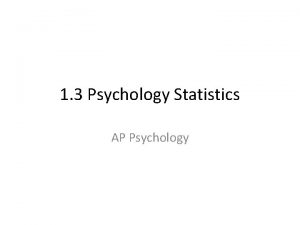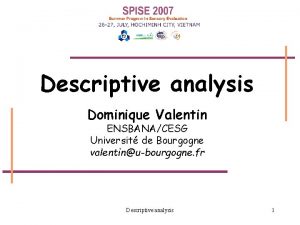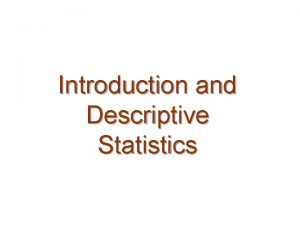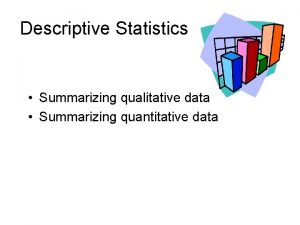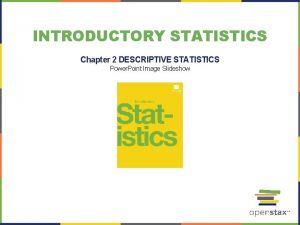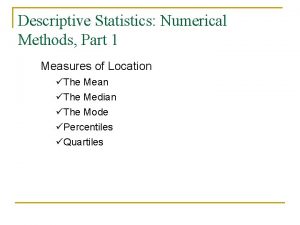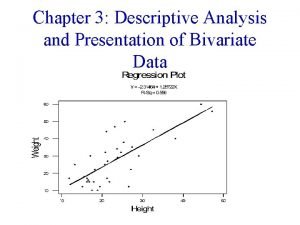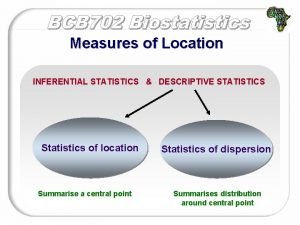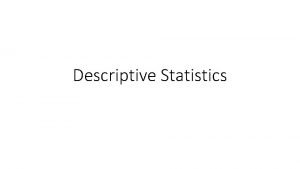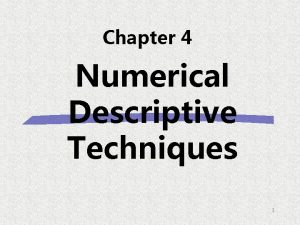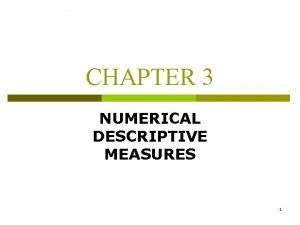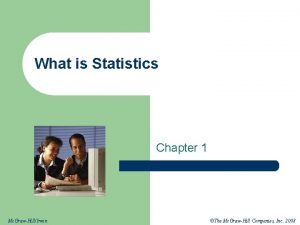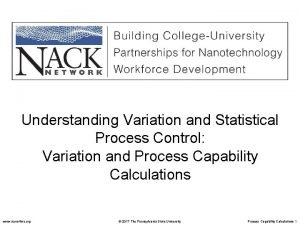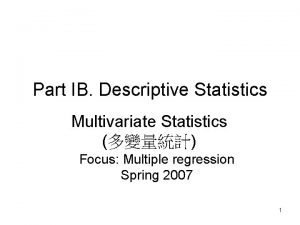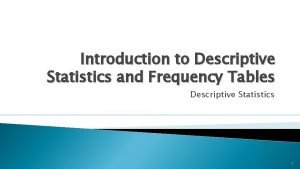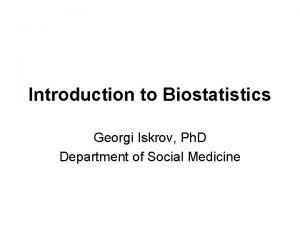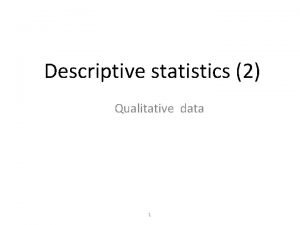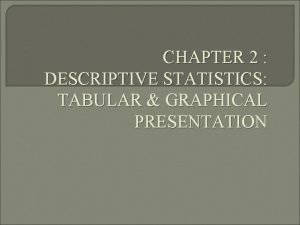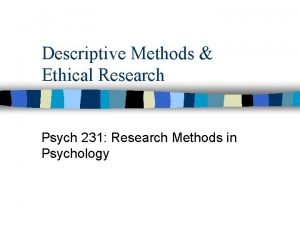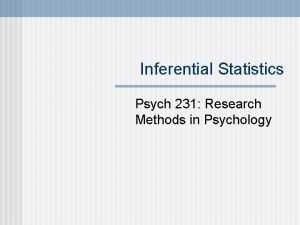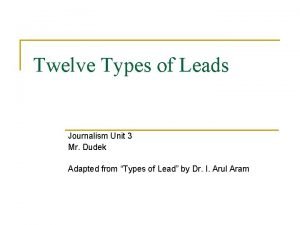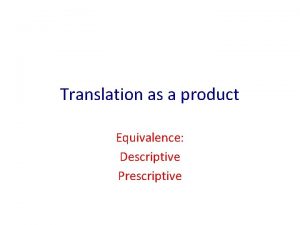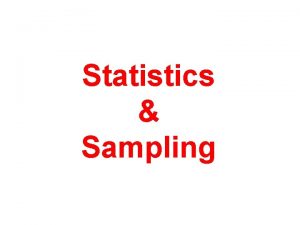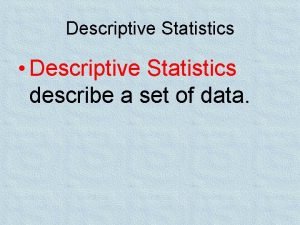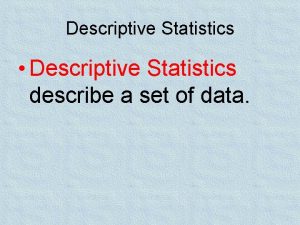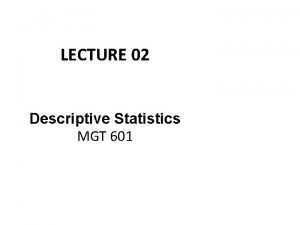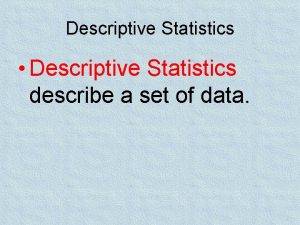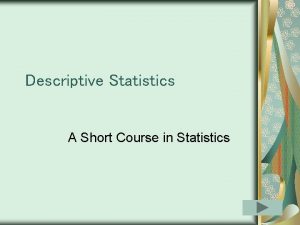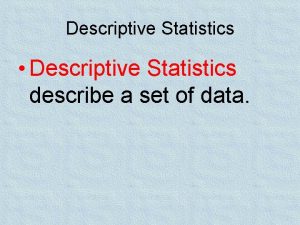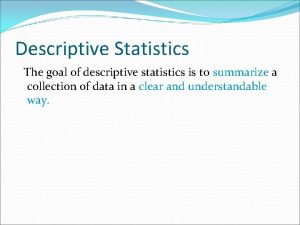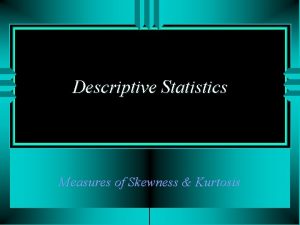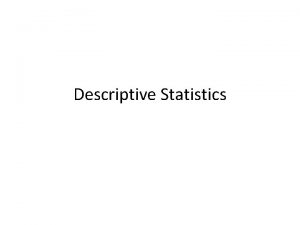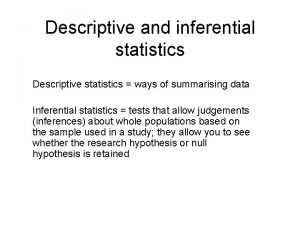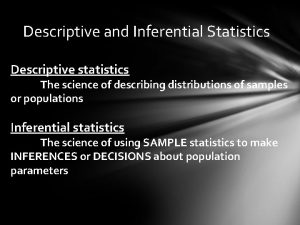1 3 Psychology Statistics AP Psychology Descriptive Statistics







































- Slides: 39

1. 3 Psychology Statistics AP Psychology

Descriptive Statistics • Definition… • Describe a set of data • Measures of Central Tendency • Measures of Variation • Skewed Distributions

Measures of Central Tendency • Mean – Average score – Extreme scores have a greater impact on the mean than on the mode or median • Median – Score that divides a frequency distribution exactly in half, so that the same number of scores lie on each side (middle) • Mode – Most frequently occurring score (bimodal)




Measures of Variation • Definition – Measure of variation in a single score that presents info about the spread of scores in a variation • Range – highest minus the lowest • Standard Deviation – a standard measurement of how much the scores in a distribution deviate from the mean – The most widely used measure of variation • Z-score (standard score) – the distance of a score from the mean in units of standard deviation


Normal Distribution • Form a bell-shaped or symmetrical curve

Normal Distribution • The percentage of scores that fall at or above the mean is 50…the percentage that fall below (or at) the mean is also 50

Normal Distribution • One-third of the scores fall one standard deviation below the mean and one-third fall one standard deviation above the mean • Example…Wechsler IQ Tests – Mean = 100 / Standard Deviation = 15 – One-third score 85 -100 – Another third score 100 -115


68 -95 -99. 7 Rule • 68% of scores fall within one SD • 95% of scores fall within two SD • 99. 7% of scores fall within three SD

Percentile • Distance of a score from “ 0” • Examples – 90 th percentile – score better than 90% – 38 th percentile – score better than 38%


Skewed Distributions

Skewed Distributions • Positively Skewed Distributions • Contain a preponderance of scores on the low end of the scale (looks like “P” lying on back • Mean is higher than the median – Thus the median is a better representation of central tendency in positively skewed distributions

Skewed Distributions • Negatively Skewed Distributions • Contain a preponderance of scores on the high end of the scale • Mean is lower than median – Thus the median is a better representation of central tendency in a negatively skewed distribution



Inferential Statistics • Key points… • Most experiments are conducted with a small sample of subjects • Psychologists want to generalize the results from their small sample to a larger population • IS are used to determine how likely it is that a study’s outcome is due to chance and whether the outcome can be legitimately generalized to the larger population from the sample selected



The P-Value • Probability of concluding that a difference exists when in fact this difference does not exist • A statistically significant difference is a difference not likely due to chance (shows up 5% of the time or less) • Smaller the p-value, the more significant the results • Can never be “ 0” (researchers can never be 100% certain the results did not occur by chance)




Standard Deviation Find the variance. a) Find the mean of the data. b) Subtract the mean from each value. c) Square each deviation of the mean. d) Find the sum of the squares. e) Divide the total by the number of items. Take the square root of the variance.

Standard Deviation Formula The standard deviation formula can be represented using Sigma Notation: Notice the standard deviation formula is the square root of the variance.

Find the variance and standard deviation The math test scores of five students are: 92, 88, 80, 68 and 52. 1) Find the mean: (92+88+80+68+52)/5 = 76. 2) Find the deviation from the mean: 92 -76=16 88 -76=12 80 -76=4 68 -76= -8 52 -76= -24

Find the variance and standard deviation The math test scores of five students are: 92, 88, 80, 68 and 52. 3) Square the deviation from the mean:

Find the variance and standard deviation The math test scores of five students are: 92, 88, 80, 68 and 52. 4) Find the sum of the squares of the deviation from the mean: 256+144+16+64+576= 1056 5) Divide by the number of data items to find the variance: 1056/5 = 211. 2

Find the variance and standard deviation The math test scores of five students are: 92, 88, 80, 68 and 52. 6) Find the square root of the variance: Thus the standard deviation of the test scores is 14. 53.

Standard Deviation A different math class took the same test with these five test scores: 92, 92, 52. Find the standard deviation for this class.

Hint: 1. Find the mean of the data. 2. Subtract the mean from each value – called the deviation from the mean. 3. Square each deviation of the mean. 4. Find the sum of the squares. 5. Divide the total by the number of items – result is the variance. 6. Take the square root of the variance – result is the standard deviation.

Solve: A different math class took the same test with these five test scores: 92, 92, 52. Find the standard deviation for this class.

The math test scores of five students are: 92, 92, 52 and 52. 1) Find the mean: (92+92+92+52+52)/5 = 76 2) Find the deviation from the mean: 92 -76=16 52 -76= -24 3) Square the deviation from the mean: 4) Find the sum of the squares: 256+256+576= 1920

The math test scores of five students are: 92, 92, 52 and 52. 5) Divide the sum of the squares by the number of items : 1920/5 = 384 variance 6) Find the square root of the variance: Thus the standard deviation of the second set of test scores is 19. 6.

Analyzing the data: Consider both sets of scores. Both classes have the same mean, 76. However, each class does not have the same scores. Thus we use the standard deviation to show the variation in the scores. With a standard variation of 14. 53 for the first class and 19. 6 for the second class, what does this tell us?
 Descriptive statistics ap psychology
Descriptive statistics ap psychology Descriptive statistics examples in business
Descriptive statistics examples in business Descriptive hypothesis
Descriptive hypothesis Example of descriptive statistics
Example of descriptive statistics Introduction to descriptive statistics
Introduction to descriptive statistics How to summarize qualitative data
How to summarize qualitative data Chapter 2 descriptive statistics answer key
Chapter 2 descriptive statistics answer key Numerical descriptive statistics
Numerical descriptive statistics Numerical methods of descriptive statistics
Numerical methods of descriptive statistics Bivariate descriptive statistics
Bivariate descriptive statistics Descriptive statistics
Descriptive statistics Kinds of descriptive statistics
Kinds of descriptive statistics Jack in the
Jack in the Variance standard deviation formula
Variance standard deviation formula Inferential statistics definition
Inferential statistics definition Descriptive statistics
Descriptive statistics Definition of descriptive statistics
Definition of descriptive statistics Multivariate descriptive statistics
Multivariate descriptive statistics Descriptive statistics frequency distribution
Descriptive statistics frequency distribution Types of statistics
Types of statistics Descriptive statistics classification
Descriptive statistics classification Descriptive statistics tabular and graphical methods
Descriptive statistics tabular and graphical methods Descriptive statistics in google sheets
Descriptive statistics in google sheets Descriptive methods psychology
Descriptive methods psychology Introduction to statistics what is statistics
Introduction to statistics what is statistics Inferential statistics
Inferential statistics Inferential statistics ap psychology
Inferential statistics ap psychology Positive psychology ap psychology definition
Positive psychology ap psychology definition Social behavior psychology definition
Social behavior psychology definition Fundamental attribution error ap psychology
Fundamental attribution error ap psychology History and origin of science of psychology slideshare
History and origin of science of psychology slideshare Social psychology definition psychology
Social psychology definition psychology Health psychology definition ap psychology
Health psychology definition ap psychology Research problem statement and objectives examples
Research problem statement and objectives examples Example of descriptive paragraph
Example of descriptive paragraph Descriptive heading examples
Descriptive heading examples Tambúr
Tambúr Advantages of descriptive research
Advantages of descriptive research What is anecdotal lead
What is anecdotal lead Descriptive equivalent translation
Descriptive equivalent translation
